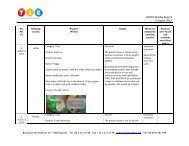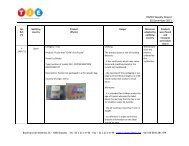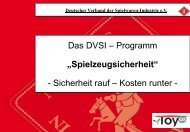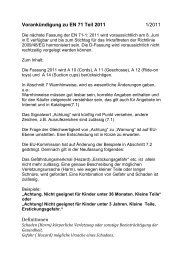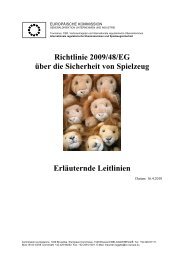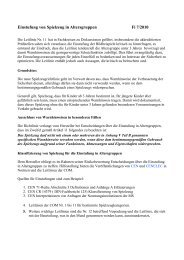You also want an ePaper? Increase the reach of your titles
YUMPU automatically turns print PDFs into web optimized ePapers that Google loves.
<strong>EN</strong> <strong>71</strong>-1:<strong>2005+</strong><strong>A8</strong>:2009 (E)<br />
⎯ Operate a cap-firing toy using percussion caps recommended by the manufacturer and which are<br />
available on the market.<br />
⎯ Operate tape-players, CD-players and similar electronic toys, provided with headphones or earphones,<br />
with a standardised recording.<br />
NOTE Further work is needed to obtain standardized recordings. In the interim, the following recordings may be<br />
used: Recorded tape created by BASF and TEAC for IEC in March 1981, called TEAC test tape – Level 1 kHz – 0 dB.<br />
8.28.2 Measurement procedure<br />
8.28.2.1 Basic standards to be used<br />
The minimum requirement is to determine emission sound pressure levels at the specified positions around<br />
the toy according to <strong>EN</strong> ISO 11202 and <strong>EN</strong> ISO 11204, which are survey methods. In case of dispute, the<br />
more accurate <strong>EN</strong> ISO 11201 shall be used.<br />
NOTE 1 Because of fewer reflections from the room boundaries, <strong>EN</strong> ISO 11201 will tend to give slightly lower values<br />
than <strong>EN</strong> ISO 11202 and <strong>EN</strong> ISO 11204.<br />
NOTE 2 In certain cases, <strong>EN</strong> ISO 11204 can have the accuracy of an engineering method.<br />
8.28.2.2 Instrumentation<br />
The instrumentation system, including the microphone and cable, shall meet the requirements of a type 1 or<br />
type 2 instrument specified in IEC 61672-1 and IEC 61672-2 or, in the case of integrating-averaging sound<br />
level meters, in IEC 61672-1 and IEC 61672-2. When measuring high peak emission sound pressure levels,<br />
e.g. from toys using percussion caps, the microphone and the entire instrumentation system shall have the<br />
capability of handling linear peak levels exceeding the C-weighted peak levels by at least 10 dB. When<br />
<strong>EN</strong> ISO 11201 is used, a type 1 instrument is required.<br />
8.28.2.3 Microphone positions<br />
8.28.2.3.1 General<br />
Several microphone positions shall be used. In practice this often means that one microphone is moved from<br />
position to position. Whenever it is practicable, it is always an alternative to rotate the test object instead.<br />
Attention shall be paid to maintaining the correct measuring distance.<br />
8.28.2.3.2 Close-to-the-ear toys<br />
Locate the position of the maximum sound pressure level (LPA) (see 8.28.2.4) of a close-to-the-ear toy by<br />
moving the toy or the measuring microphone so that the measuring distance is (2,5 ± 0,5) cm from that<br />
surface of the toy where the main sound source exists. This position is the microphone position for<br />
measurements. For earphones and headphones the microphone positions are given by the coupler.<br />
8.28.2.3.3 Child-actuated and hand-held toys<br />
8.28.2.3.3.1 Cap-firing toy<br />
Use six microphone positions around the toy. Place the main sound emitting part of the toy at the origin of the<br />
measuring coordinate system in its normal operating orientation in such a way that the main axes of the toy<br />
coincide with the axes of the measuring coordinate system -(see Figure 27).. If the length of the toy<br />
exceeds 50 cm, rotate the toy in the xy-plane 45° around the z-axis without changing the microphone<br />
positions.<br />
67



